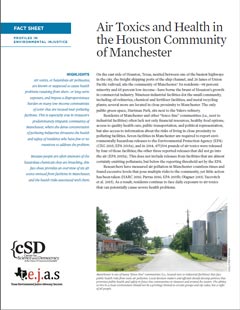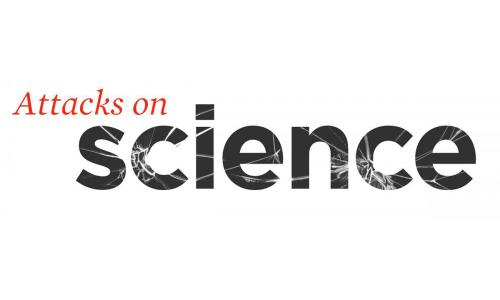No one should have to live in fear that the air they breathe is making them sick. But for residents of Manchester, a community on the east side of Houston, TX, this is a daily reality.
The reason? Toxic air pollutants released by nineteen industrial facilities—including oil refineries, chemical and fertilizer facilities, and metal recycling plants.
As with many other "fenceline" communities in the US, Manchester residents—who are 98 percent minority and 65 percent low-income—lack access to information about the risks of living in close proximity to these polluting facilities.
As our fact sheet Air Toxics and Health in the Houston Community of Manchester has documented, seven facilities in Manchester are required to report environmentally hazardous releases to the Environmental Protection Agency (EPA). In 2014, four of those facilities released 477,594 pounds of air toxics. (This figure does not include likely releases from other facilities whose emissions fall below the EPA's reporting threshold.)
Researchers have measured air pollution in Manchester countless times and found excessive levels that pose multiple risks to the community, yet little action has been taken. As a result, residents continue to face daily exposure to air toxics that can cause severe health problems.

Health impacts of air toxics
Regular exposure to air toxics may worsen the health of people who have pre-existing heart and lung ailments or breathing difficulties; adults over the age of 65 and children under 18 are also at higher risk of illness related to chemical exposure. Other health concerns associated with long-term exposure include the potential for developing cancer over the course of a lifetime, as well as a variety of respiratory, neurological, immune, and reproductive issues.
Our fact sheet provides an overview of six air toxics found in Manchester and their potential health effects. Two things to note: the fact sheet does not address the impact of exposure to multiple chemicals at the same time, as there is no definitive research on cumulative risk from air toxics. Also, while monitoring air quality does offer information about the living environment in Manchester, exposure to any of these chemicals will not necessarily lead to the symptoms or illnesses listed.
What Exactly Is In Manchester's Air?
These are not the only air toxics found in Manchester; they were chosen because they are on the EPA's list of 187 hazardous air pollutants regulated under the federal Clean Air act, and they are found in high quantities in Manchester.
1,3-Butadiene is a flammable, colorless gas with a gasoline-like odor.
SOURCE: Released from petroleum processing
USED in synthetic rubber for car and truck tires, and in plastics such as acrylics
SHORT-TERM EXPOSURE may cause irritation of the eyes, nose, throat, and lungs; headaches; fatigue; decreased blood pressure and pulse; central nervous system damage; and unconsciousness
LONG-TERM EXPOSURE can cause cancer and increases the likelihood of leukemia
DETECTION: Medical tests are not yet available
Benzene is a flammable, colorless liquid with a sweet odor that readily evaporates.
SOURCE: Occurs naturally in crude oil and gasoline
USED in plastics, rubbers, synthetic fibers, dyes, detergents, drugs, and pesticides
SHORT-TERM EXPOSURE to high levels may cause headaches, termors, drowsiness, dizziness, and even death
LONG-TERM EXPOSURE can cause anemia, and high levels can cause leukemia. Women who breathe in high levels over a span of several months may experience irregular menstrual periods and smaller ovaries.
DETECTION: Can be measured in the breath, urine, and blood, but tests must be done soon after exposure
Ethylbenzene is a colorless, flammable liquid with a gasoline-like odor.
SOURCE: Occurs naturally in crude oil; released from petroleum processing
USED in styrene production
SHORT-TERM EXPOSURE to high levels may cause dizziness and irritation of the eyes and throat
DETECTION: Can be detected in urine if tested within a few hours of exposure
Styrene is a highly explosive, colorless liquid.
USED in plastics, rubbers, insulation, fiberglass, and automobile parts
EXPOSURE may cause irritation of the lungs, eyes, nose, and skin
HIGH LEVELS of exposure may cause changes in color vision, tiredness, slowed reaction time, difficulty with balance, and cancer
DETECTION: Can be measured in blood, urine, and body tissues if tested within one day of exposure
Toluene is a colorless liquid with a sweet odor.
SOURCE: Occurs naturally in crude oil; released from petroleum processing
USED in plastics, rubbers, synthetic fibers, paints, and fingernail polish
LOW to MODERATE LEVELS can cause fatigue, weakness, memory loss, nausea, and appetite loss that generally fade when the exposure ends
LONG-TERM EXPOSURE may cause irritation of the eyes, throat, and lungs; headaches; and dizziness. May also affect the nervous and reproductive systems and cause developmental problems in children.
DETECTION: Can be detected in blood and urine, but testing requires special equipment and must be done soon after exposure
Xylene is a colorless, sweet-smelling liquid or gas.
SOURCE: Occurs naturally in crude oil; released from petroleum processing
USED in rubber
SHORT- or LONG-TERM EXPOSURE at high levels may cause headaches, dizziness, lack of balance, difficulty breathing, memory difficulties, and irritation of the skin, eyes, nose, and throat
DETECTION: Can be measured in urine if tested within a few hours of exposure
Shifting the burden
Every day, Manchester residents live at risk of exposure to these air pollutants—as well as the risk of accidental spills and explosions. Yet the people most at risk often lack the resources and access to technical information that would help hold local officials and industries accountable.
Though evidence shows low-income communities of color face disparate levels of exposure to toxic chemicals, the burden of proving these chemicals are harming residents’ health continues to rest on the communities themselves. It should be the polluters who are expected to prove that exposure to their chemicals poses no harm.
Local decision makers and officials should immediately develop policies that prioritize public health and safety in fenceine communities in Houston and around the nation. And they should involve area residents in shaping these policies and decisions, which have a direct impact on the lives and health of residents and their families. The ability to live in a clean environment should not be a privilege limited to certain groups and zip codes, but a right of all people.




